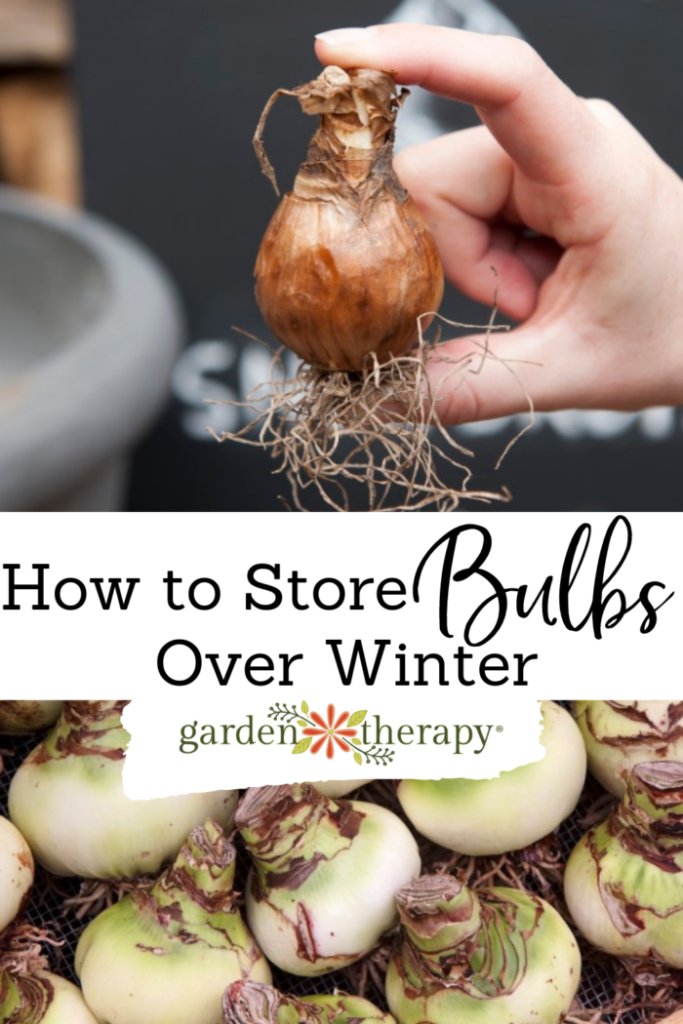Bulbs are one of the brightest, boldest ways to fill your garden with a rainbow of colours and scents. But when fall comes around, we’re not ready to say goodbye to those summer-flowering bulbs. Learn how to store bulbs over winter so you can enjoy the same flowers again next season!

Over here on Garden Therapy, I have so much advice on bulbs. I just can’t get enough of them! They’re simply one of the best, most affordable ways to fill your garden with colour, fragrance, and create a haven for bees and other pollinators.
One of the first sights of spring, bulbs represent transformation. To me, bulbs symbolize the season’s rebirth and create instant optimism. Nothing gets me quite as giddy for the gardening season as seeing bulbs!
While there are spring bulbs, there are also plenty of summer-flowering, tender bulbs. These flowers are known for being extra brilliant, providing epic colour amid the growing season. Unfortunately, these bulbs in the winter are not cold hardy and often don’t return the following season when left in the ground.
Bulbs remain one of the most affordable ways to fill your home with flowers, but when you need to replace them every year, it can add up! However, you can learn how to dig up and store bulbs over the winter and continue to use the same bulbs every growing season. Here’s how!
Jump ahead to…
Spring Bulbs Vs Summer Flowering Bulbs
Not all bulbs are the same! Spring bulbs, or the more accurate name of fall bulbs, are considered the same thing. Planted in the fall, they pop up and emerge in the spring for a splash of colour after a dreary winter.
These spring bulbs must be planted in the fall because they rely on the cold. The cold tells them to develop roots, and they know it’s time to spring up when the weather begins to warm.
On the other end, you have summer flowering bulbs. These are planted in the spring and bloom in the summer. Complete sun lovers, these plants don’t love the cold as much and may need to consider wintering bulbs. Otherwise, they’re treated as annuals.
While I’m using the term bulb, this also applies to tubers, corms, and rhizomes. All refer to the swollen underground part of the plant used to store food. However, where they store the food varies, which is the key difference in the names. But! These tips for overwintering bulbs will apply to all under the “bulb” category.
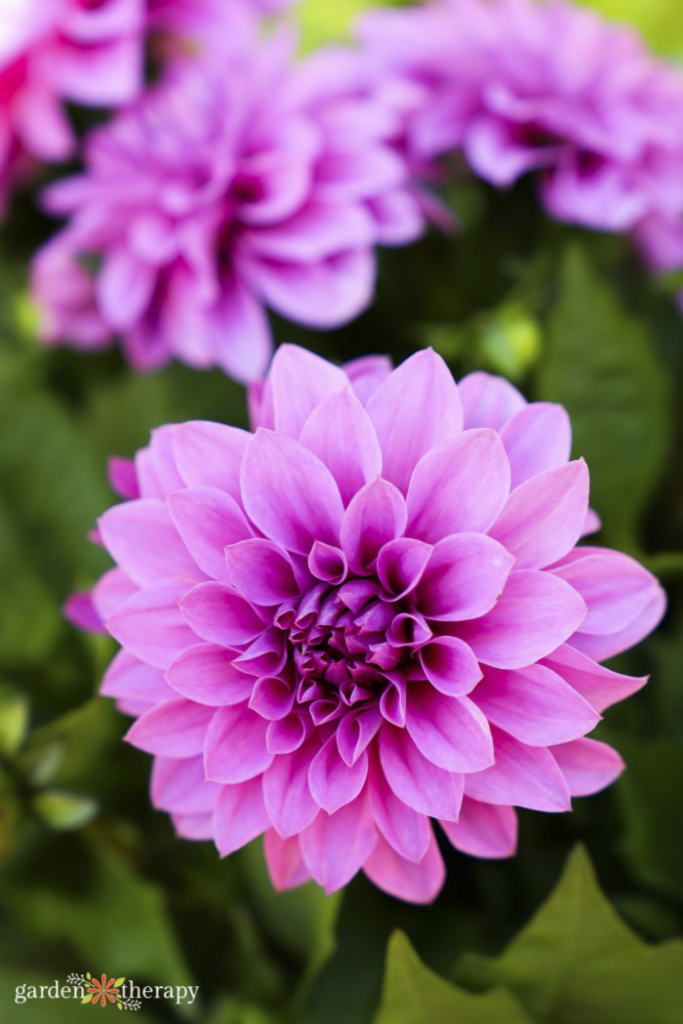

Can You Leave Bulbs in the Ground Over Winter?
When looking at what to do with your bulbs in winter, you need to determine which bulbs are sun lovers and which ones are cold-hardy. The spring bulbs should stay in the ground over winter since they rely on the cold to bloom. The summer-flowering bulbs, meanwhile, may need to be dug up, or they may rot if left in the soil.
Depending on where you live, some summer-flowering bulbs may be okay to stay in the ground. Here are some of the most popular summer-flowering bulbs and the zones they’re cold hardy in.
- Ranunculus USDA zones 8-10
- Dahlia USDA zones 8-11
- Gladiolus USDA zones 8-11
- Calla lily USDA zones 8-10
- Crocosmia USDA zones 6-9
- Freesia USDA zones 9-10
- Canna lily USDA zones 7-11
- Liatris USDA zones 3-8
- Tuberous begonia USDA zones 9-10
- Anemone USDA zones 4-8
If these bulbs are hardy in your zone, you can still help them during the winter. Wait until the foliage has completely died down before trimming it down to 2-3 inches. Add a layer of mulch over the bulbs to help retain the warmth while they rest up for the winter.
Honestly, I leave most of my summer bulbs in the garden rather than digging them up and storing them. I treat them as annuals and don’t feel guilty about letting them decompose in the ground. But I know that many people don’t want to spend money on bulbs every year or may have some specialty bulbs they want to keep. So that’s where these tips come in!
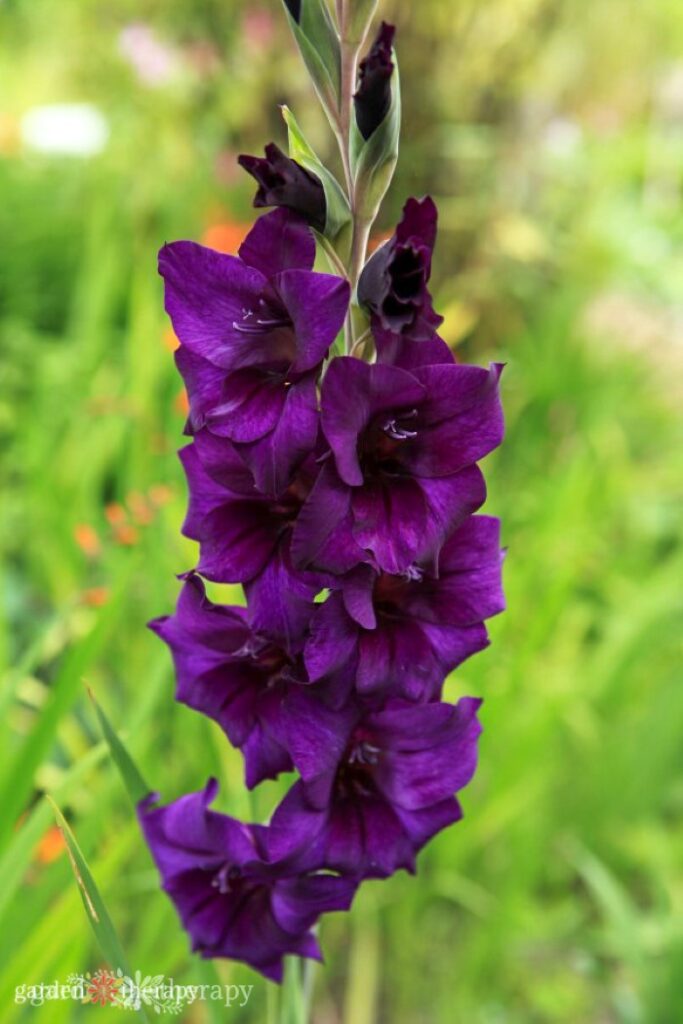

How to Store Bulbs Over Winter
If you have tender perennials, you’ll likely need to dig them up if you want to enjoy them again next season. Luckily, figuring out how to store bulbs over winter isn’t hard to do!
Dig Up Bulbs
Those bulbs need to get out of the ground! You’ll want to harvest the bulbs once all the foliage is dead. The leaves should easily pull away when tugged at. This should be done before the first frost, or it may be too late for the bulbs.
Use a garden fork to gently dig up the bulbs. Once again, be gently or you may pierce delicate root systems (like dahalia tubers).
Carefully brush the excess dirt off the bulbs. You can even rinse them if you’d like. Trim the foliage to 2-3 inches and cut any long, dangling roots.
Dry Out Bulbs
The bulbs will be full of moisture, so it’s vital to let them air dry before you pack them away for the winter.
First things first, make sure you label everything. Once dug up, all bulbs will look the same. So ensure you have masking or flagging tape and Sharpie ready to label all containers the bulbs will go in.
Set out newspaper or paper towel in a warm, dry place. Lay the bulbs out and allow them to sit for a couple of days. Let them completely dry and be free of any moisture before storing them.
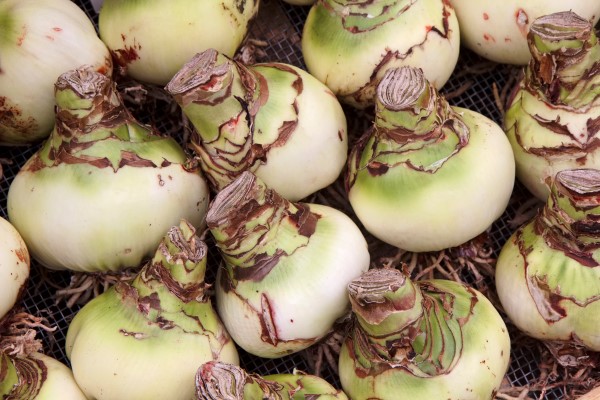

Store Bulbs
Storing bulbs is a delicate balance, as you don’t want them to get moist and become mouldy or rotten. However, you don’t want them to completely shrivel and dry up either. So ideally, you want to keep the moisture the bulbs have after drying out for a couple of days, but not obtaining any more.
Place your bulbs in a plastic container or cardboard box. Put down one layer, trying to ensure the bulbs don’t touch one another (in case one gets mouldy, you don’t want it to spread). Add a layer of growing medium, such as coconut coir, vermiculite, or sawdust. Ensure the tops are fully covered.
Add another layer of bulbs and growing medium, ensuring they all get enough air circulation.
There are many different ways to store bulbs. People will all have their own suggestions on the best storage methods, and one isn’t necessarily better than the other. For instance, Holly, our Content Manager, stores her dahlia tubers in plastic saran wrap, wrapping up divided tubers and storing them in a cardboard box.
Check the bulbs every once in a while to look for signs of rot, disposing of any rotten bulbs. Let the bulbs rest for a few months before planting again.
Depending on where you live, this should be around four months. Bulbs won’t usually last more than a year on storage, so planting late is better than never!
Plant Bulbs
Planting times will vary based on your location and the bulb type, but typically most tender bulbs should be planted after the last frost. When taking bulbs out of storage, any healthy bulbs will be large and firm. Get rid of any that look mushy or cracked.
When you’re ready to plant, check out this planting guide for summer-flowering bulbs.
Overwintering Bulbs in Containers
One of my favourite ways to display bulbs is in containers. You can dig up some of your spring bulbs, or plant new ones altogether, to get an impressive display of colour in the spring.
With careful layering and the right container choice, you can easily do the work in the fall for a gorgeous spring. Check out my layering technique here!
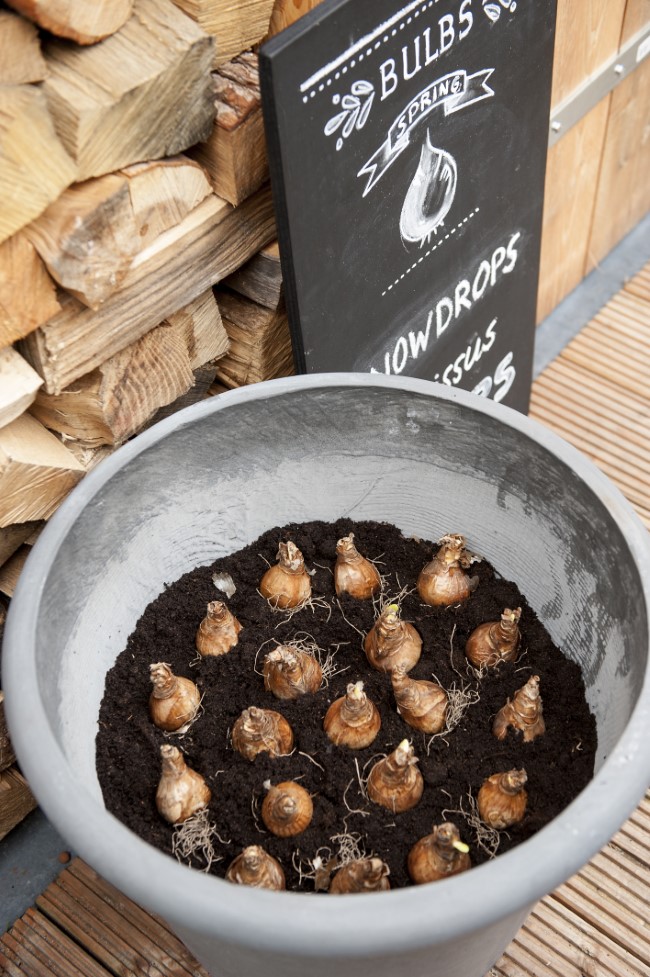

Frequently Asked Questions About Wintering Bulbs
Overwintering is the steps taken to help ensure a plant survives the winter. Typically, this involves protecting the plants from the cold by doing things like moving them inside or to a sheltered area, covering them with a protective layer, adding mulch, etc. Some plants need help overwintering, and others are fine all on their own.
This depends on the type of bulb. Spring bulbs should be left in the ground year-round. They require the cold to develop their roots and need the winter as part of their process.
As for tender, summer-flowering bulbs, follow your zone rules as to whether or not you need to winterize the bulbs. Most will need to be dug up before the first frost and brought inside to be dried and stored for the winter to be used again.
Tender bulbs do not need to be watered. You want to avoid moisture and promote circulation as much as possible.
As for spring/fall bulbs, you want to water them as soon as you plant them in the fall in a well-draining area. Once things cool down, you don’t need to water or protect them. All the work is done!
That covers everything about how to winterize bulbs! Just taking an hour in the fall to dig up your bulbs will allow you to enjoy your flowers again and again.
More Posts About Bulbs


